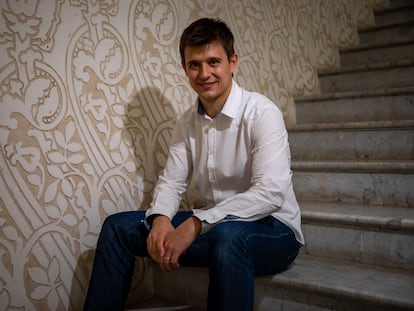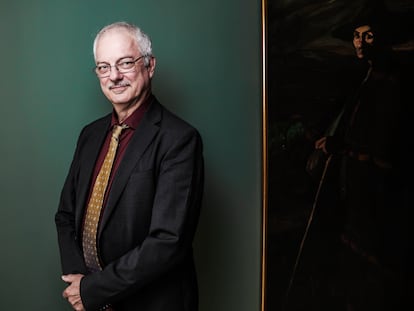Artificial placenta keeps sheep fetus alive for 12 days: ‘We have to cheat nature’
A trial led by Spanish researchers is hoping to help extremely premature babies survive outside the mother’s womb

The first European project to develop artificial placentas for extremely premature babies has announced the results of its first phase. Researchers at Hospital Clínic and Sant Joan de Déu in Spain managed to keep a sheep fetus alive for 12 days in a highly complex extracorporeal system that simulates the natural placenta. The experts believe that the result open the door to the possibility that within three years, there will be a prototype for clinical studies and that the artificial placenta will be able to guarantee survival for up to “three or four weeks.”
The trial seeks to reproduce and prolong the physiological conditions of the mother’s uterus. At six months (26 weeks), the fetus’s lungs, intestines, and brain are underdeveloped and not ready to function properly outside of the natural placenta. “An extremely premature newborn is, in reality, a fetus that must survive in a very unnatural environment,” explain the experts. The artificial placenta aims to become the most suitable environment possible for the newborn. In Europe, about 25,000 extremely premature babies are born every year.
The process involves many challenges. Firstly, there is the difficulty in guaranteeing the fetus can be safely transferred from the mother’s placenta to the artificial placenta. The umbilical cord, which ensures the exchange of nutrients and oxygen between the embryo and the placenta, closes irreversibly when there is a drop in temperature of two degrees because it believes that the baby has left the womb. “We have to cheat nature,” says Eduard Gratacós, the project leader. The team ensured that all the transitions made in the last year were successful.
The first prototype developed is composed of a translucent container, which is made of biocompatible material and connected to an amniotic fluid circulation system that allows the fetus to be kept in a liquid environment and isolated from external stimuli, but accessible for ultrasound checks and ongoing monitoring.
The system includes an extracorporeal circulation system, made up of an oxygenating membrane and a system of parts designed to facilitate blood circulation and oxygenation, which simulates what occurs naturally in intrauterine life. “We have created an environment with a fluid that is exactly the same as the one that surrounds the fetus in the natural placenta, because any difference is very noticeable,” says Gratacós.
The project worked with about 50 sheep fetuses, as they have a similar size and pulmonary and cardiovascular systems to human fetuses. Of these sheep fetuses, three have managed to survive 12 days and a few more (the exact number has not been specified), between nine and 10 days.
After this first phase, which began in 2020, a second phase will try to extend survival to four weeks, bringing the whole system to an “extreme” level of safety. A bioethical framework will also be developed. “In the future, we don’t know when, there will be artificial placentas,” says Gratacós.
“Hospitals should involve parents and other relevant groups in the community when drawing up solid and exhaustive guidelines for their use,” says Kelly Werner, associate professor of Pediatrics in the Division of Neonatology at Columbia University, in New York, in statements to Science Media Centre Spain. The pediatrician has called for specific protocols for the use of artificial womb technology and insists on guaranteeing natural deliveries. “Although this is an encouraging advance, the artificial placenta is not intended to replace the natural placenta. In other words, despite these advances, we must do everything possible to support maternal health and decrease the risk factors that lead to preterm delivery.”
Other similar studies are currently underway in the United States, Japan and Australia. A similar artificial placenta model is being developed at the University of Michigan in the United States, while artificial womb models are being developed at the University of Pennsylvania (United States), Tohoku University (Japan) and the University of Western Australia. According to the Spanish researchers, only the Philadelphia project has achieved better results. “They achieved a maximum of 28 days. The rest, were between seven and 10 days. The Barcelona project is very solid,” says Gratacós.
Sign up for our weekly newsletter to get more English-language news coverage from EL PAÍS USA Edition
Tu suscripción se está usando en otro dispositivo
¿Quieres añadir otro usuario a tu suscripción?
Si continúas leyendo en este dispositivo, no se podrá leer en el otro.
FlechaTu suscripción se está usando en otro dispositivo y solo puedes acceder a EL PAÍS desde un dispositivo a la vez.
Si quieres compartir tu cuenta, cambia tu suscripción a la modalidad Premium, así podrás añadir otro usuario. Cada uno accederá con su propia cuenta de email, lo que os permitirá personalizar vuestra experiencia en EL PAÍS.
¿Tienes una suscripción de empresa? Accede aquí para contratar más cuentas.
En el caso de no saber quién está usando tu cuenta, te recomendamos cambiar tu contraseña aquí.
Si decides continuar compartiendo tu cuenta, este mensaje se mostrará en tu dispositivo y en el de la otra persona que está usando tu cuenta de forma indefinida, afectando a tu experiencia de lectura. Puedes consultar aquí los términos y condiciones de la suscripción digital.
More information
Últimas noticias
NASA discovers Titan doesn’t have an ocean, but a ‘slushy ice layer’ that increases possibility of life
Innocence lost in the forest of the child soldiers: ‘Each leader of the armed group had his girls’
‘Fallout’ or how the world’s largest company turned an anti-capitalist apocalyptic Western into a phenomenon
From inflation to defending migrants: Eileen Higgins and Zohran Mamdani inaugurate the new Democratic resistance against Trump
Most viewed
- ‘El Limones’ and the growing union disguise of Mexican organized crime
- Christian Louboutin: ‘Young people don’t want to be like their parents. And if their parents wear sneakers, they’re going to look for something else’
- The low-cost creative revolution: How technology is making art accessible to everyone
- ‘We are dying’: Cuba sinks into a health crisis amid medicine shortages and misdiagnosis
- A mountaineer, accused of manslaughter for the death of his partner during a climb: He silenced his phone and refused a helicopter rescue











































